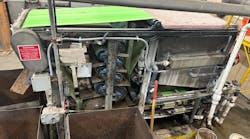The Bluebonnet Water Supply Corp. Water Treatment Plant in Temple, Texas, generated a worst-case 106 million gal of spent backwash water and clarifier sludge annually, storing it in three concrete lagoons. Solids in the settling lagoon never dried sufficiently to permit effective removal. Handling the monthly average waste of 266,000 gal per day of sludge and paying a hauler to transport it was a considerable operational effort and expense for the facility.
Sludge Collection Basins
Bluebonnet added three modified sludge collection basins with vacuum transport units, two lift stations, and a Poly-Mate polymer system and Sludge-Mate dewatering containers from Flo Trend Systems. The three basins are active, having material settling in the bottom of them to a depth of no more than 1 ft before the sludge is transferred. When the sludge collection system activates, 19,600 lb of solids flow to the first lift station where the material is dewatered to 15% solid cake. Filtrate drains to the second lift station and returns to the headworks of the plant.
Positive Results
The chief of operations and staff at Bluebonnet Water Supply Corp. now can stay ahead of sludge production and control disposal costs.
Download: Here



